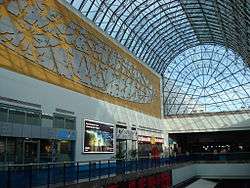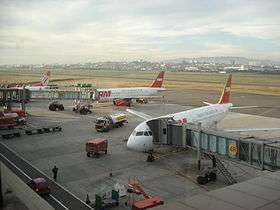Salgado Filho International Airport
| Salgado Filho International Airport Aeroporto Internacional Salgado Filho | |||||||||||
|---|---|---|---|---|---|---|---|---|---|---|---|
 | |||||||||||
| Summary | |||||||||||
| Airport type | Public | ||||||||||
| Operator | Fraport | ||||||||||
| Serves | Porto Alegre | ||||||||||
| Focus city for | Azul Brazilian Airlines | ||||||||||
| Elevation AMSL | 3 m / 11 ft | ||||||||||
| Coordinates | 29°59′38″S 051°10′16″W / 29.99389°S 51.17111°WCoordinates: 29°59′38″S 051°10′16″W / 29.99389°S 51.17111°W | ||||||||||
| Website | Fraport | ||||||||||
| Map | |||||||||||
 POA Location in Brazil | |||||||||||
| Runways | |||||||||||
| |||||||||||
| Statistics (2016) | |||||||||||
| |||||||||||
Salgado Filho International Airport (IATA: POA, ICAO: SBPA) is the airport serving Porto Alegre, Brazil. It is named after the Senator and first Minister of the Brazilian Air Force Joaquim Pedro Salgado Filho (1888–1950). It is operated by Infraero.
History


Salgado Filho was originally called São João Federal Airport, after the neighborhood where it is located. In the beginning it was an air club, where the first flights landed on May 31, 1923.
In 1932, needing a facility to use its aircraft with landing-gear which were replacing its seaplanes, Varig started using São João Airport as its operational base. However, it was only in 1940 that the first passenger terminal was inaugurated.[4]
On October 12, 1951, São João Federal Airport was renamed Salgado Filho Airport, after the Senator and Minister who died the year before on a crash involving a SAVAG aircraft that departed from Porto Alegre.
In 1953 the old terminal was incorporated into the maintenance facilities of Varig, a new passenger terminal was opened,[5] and runways were paved. Until that year larger aircraft such as Lockheed L-049 Constellations had to land at Canoas Air Force Base.[6] This new terminal is known as Passenger Terminal 2. It underwent major renovations and enlargements between 1969 and 1971 but unable to cope with the increasing traffic, another brand new facility was built. This new facility was named Passenger Terminal 1 and opened on September 11, 2001. Terminal 2 became underused by general aviation and cargo services.
However, in order to cope with the increasing passenger traffic at the airport, on September 8, 2010 a decision was made to renovate Terminal 2 and bring it back into passenger use.[7] It became operational on December 4, 2010.[8]
The total area of the Salgado Filho Airport is about 3,805,810.04 m² with 142,750 m² of ramp area. Terminal 1 has 37,600 m² and 16 gates with jetways. Terminal 2 has 15,540 m². In front of terminal 1 there is a carpark with 1,440 places. Terminal 1 is the first facility in Latin America with a shopping mall.
One of the two TAP Maintenance & Engineering centers in Brazil is located at Salgado Filho International Airport.
Terminals, airlines and destinations
Passenger
Cargo
| Airlines | Destinations |
|---|---|
| Florida West International Airways | Miami |
| LATAM Cargo Chile | Miami |
| Total Linhas Aéreas | São Paulo-Guarulhos |
Ground transportation
The airport is served by rail, taxi, and bus.
Train
People mover (Aeromóvel) connects the International Airport to the Porto Alegre Metro Airport Station since August 10, 2013.[10] Porto Alegre Metro connects Downtown Porto Alegre with the International Airport and cities of metropolitan area.
Taxi
Terminals 1 and 2 have taxi services.
Bus
Bus routes T5, T11, and B09 link Terminal 1 - International Airport to the city of Porto Alegre.
Abandoned Aircraft
Accidents and incidents
- February 28, 1942: a Varig Junkers Ju-52/3m registration PP-VAL crashed shortly after take-off from Porto Alegre. Seven of the 23 occupants died, including 2 crew members.[11][12]
- June 20, 1944: a Varig Lockheed 10 A/E Electra registration PP-VAQ on approach to Porto Alegre after a flight from Pelotas during a storm crashed on the waters of Guaíba river. All 10 passengers and crew died.[13][14]
- August 2, 1949: a Varig Curtiss C-46AD-10-CU Commando registration PP-VBI operating a flight from São Paulo-Congonhas Airport to Porto Alegre made an emergency landing on rough terrain near the location of Jaquirana, approximately 20 minutes before landing in Porto Alegre, following fire on the cargo hold. Of the 36 passenger and crew aboard, 5 died.[15][16]
- June 30, 1950: a SAVAG Lockheed Model 18 Lodestar registration PP-SAA, flying from Porto Alegre to São Borja in bad weather collided against a hill, caught fire and crashed near the location of São Francisco de Assis. All 10 occupants died, including the founder of SAVAG and pilot, Gustavo Kraemer, and Joaquim Pedro Salgado Filho, senator and first Minister of Air Force in Brazil.[17][18]
- October 14, 1952: an Aerovias Brasil Douglas C-47-DL registration PP-AXJ operated by Real Transportes Aéreos en route from São Paulo-Congonhas to Porto Alegre struck high ground while flying under adverse conditions over the location of São Francisco de Paula. Of the 18 passengers and crew aboard, 14 died.[19][20]
- October 18, 1957: a Varig Douglas C-47A-80-DL registration PP-VCS operating a cargo flight from Porto Alegre crashed upon take-off. The crew of two died.[21]
- May 30, 1972: a Varig Lockheed L-188 Electra registration PP-VJL operating a flight between São Paulo-Congonhas to Porto Alegre was hijacked. The hijacker demanded money. The aircraft was stormed and the hijacker shot.[22]
See also
References
![]() This article incorporates public domain material from the Air Force Historical Research Agency website http://www.afhra.af.mil/.
This article incorporates public domain material from the Air Force Historical Research Agency website http://www.afhra.af.mil/.
- ↑ "Estatísticas" (in Portuguese). Infraero. Retrieved 22 April 2017.
- ↑ "Airport Official Website" (in Portuguese). Infraero.
- ↑ "Lista de aeródromos públicos" (in Portuguese). ANAC.
- ↑ Beting, Gianfranco; Beting, Joelmir (2009). Varig: Eterna Pioneira (in Portuguese). Porto Alegre and São Paulo: EDIPUCRS and Beting Books. p. 35. ISBN 978-85-7430-901-9.
- ↑ Beting, Gianfranco; Beting, Joelmir (2009). Varig: Eterna Pioneira (in Portuguese). Porto Alegre and São Paulo: EDIPUCRS and Beting Books. p. 66. ISBN 978-85-7430-901-9.
- ↑ Germano da Silva, Carlos Ari César (2008). "Está faltando um". O rastro da bruxa: história da aviação comercial brasileira no século XX através dos seus acidentes 1928-1996 (in Portuguese) (2 ed.). Porto Alegre: EDIPUCRS. p. 96. ISBN 978-85-7430-760-2.
- ↑ "Reformulação do antigo terminal do Aeroporto Salgado Filho é antecipada" (in Portuguese). Zero Hora. September 8, 2010. Retrieved September 15, 2010.
- ↑ Andrade, Artur Luiz (December 1, 2010). "Webjet utiliza terminal 2 do Salgado Filho (RS)" (in Portuguese). Panrotas. Retrieved December 1, 2010.
- ↑ http://www.routesonline.com/news/38/airlineroute/273810/avianca-brasil-adds-porto-alegre-brasilia-service-from-aug-2017/
- ↑ "G1 - Com a presença de Dilma, aeromóvel é inaugurado em Porto Alegre - notícias em Rio Grande do Sul". Rio Grande do Sul.
- ↑ Pereira, Aldo (1987). Breve História da Aviação Comercial Brasileira (in Portuguese). Rio de Janeiro: Europa. p. 75.
- ↑ Germano da Silva, Carlos Ari César (2008). "Verão de 1942". O rastro da bruxa: história da aviação comercial brasileira no século XX através dos seus acidentes 1928-1996 (in Portuguese) (2 ed.). Porto Alegre: EDIPUCRS. pp. 42–48. ISBN 978-85-7430-760-2.
- ↑ Pereira, Aldo (1987). Breve História da Aviação Comercial Brasileira (in Portuguese). Rio de Janeiro: Europa. p. 76.
- ↑ Germano da Silva, Carlos Ari César (2008). "O Electra e o temporal". O rastro da bruxa: história da aviação comercial brasileira no século XX através dos seus acidentes 1928-1996 (in Portuguese) (2 ed.). Porto Alegre: EDIPUCRS. pp. 61–65. ISBN 978-85-7430-760-2.
- ↑ "Accident description PP-VBI". Aviation Safety Network. Retrieved August 15, 2011.
- ↑ Germano da Silva, Carlos Ari César (2008). "Fogo a bordo". O rastro da bruxa: história da aviação comercial brasileira no século XX através dos seus acidentes 1928-1996 (in Portuguese) (2 ed.). Porto Alegre: EDIPUCRS. pp. 83–86. ISBN 978-85-7430-760-2.
- ↑ "Accident description PP-SAA". Aviation Safety Network. Retrieved August 15, 2011.
- ↑ Germano da Silva, Carlos Ari César (2008). "Salgado Filho". O rastro da bruxa: história da aviação comercial brasileira no século XX através dos seus acidentes 1928-1996 (in Portuguese) (2 ed.). Porto Alegre: EDIPUCRS. pp. 102–107. ISBN 978-85-7430-760-2.
- ↑ "Accident description PP-AXJ". Aviation Safety Network. Retrieved August 16, 2011.
- ↑ Germano da Silva, Carlos Ari César (2008). "Erro de navegação". O rastro da bruxa: história da aviação comercial brasileira no século XX através dos seus acidentes 1928-1996 (in Portuguese) (2 ed.). Porto Alegre: EDIPUCRS. pp. 112–117. ISBN 978-85-7430-760-2.
- ↑ "Accident description PP-VCS". Aviation Safety Network. Retrieved August 16, 2011.
- ↑ "Incident description PP-VJL". Aviation Safety Network. Retrieved August 16, 2011.
External links
![]() Media related to Salgado Filho International Airport at Wikimedia Commons
Media related to Salgado Filho International Airport at Wikimedia Commons
- Airport information for SBPA at World Aero Data. Data current as of October 2006.Source: DAFIF.
- Airport information for SBPA at Great Circle Mapper. Source: DAFIF (effective October 2006).
- Current weather for SBPA at NOAA/NWS
- Accident history for POA at Aviation Safety Network
- Salgado Filho Photo Archive at airliners.net
%